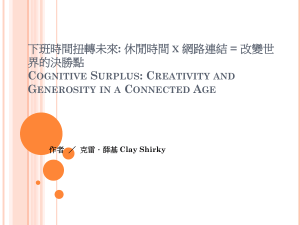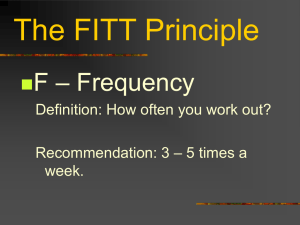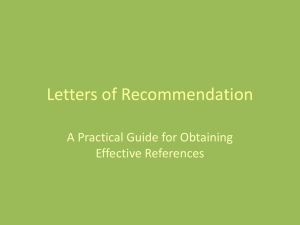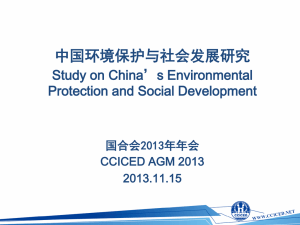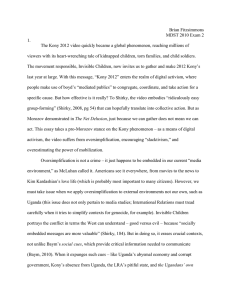Social Media and Canada Public Service
advertisement
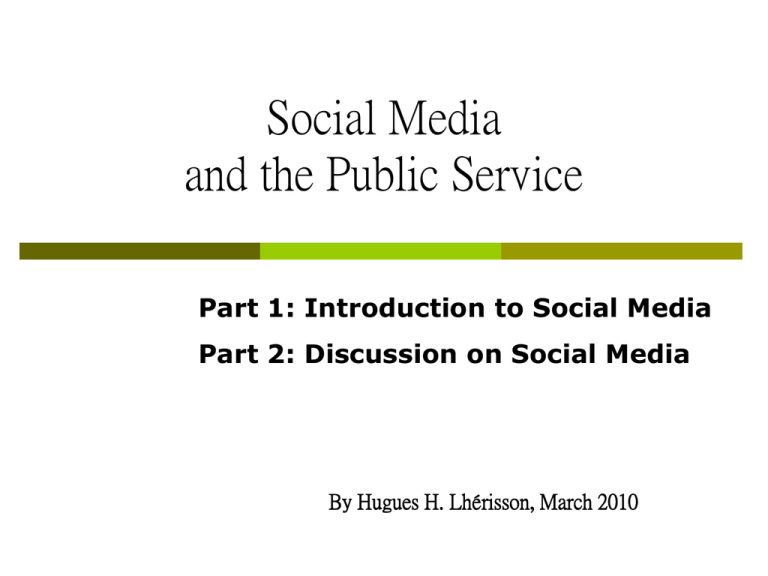
Social Media and the Public Service Part 1: Introduction to Social Media Part 2: Discussion on Social Media By Hugues H. Lhérisson, March 2010 Social Media and the Public Service Part 1: Introduction to Social Media Suggested Format: 45-60 minutes Background All governments are being asked to accomplish more within shorter time frames and smaller budgets. (…) I believe that Web 2.0 tools are part of the solution. Wayne G. Wouters, Clerk of the Privy Council of the Government of Canada. With funding provided by 23 different departments /agencies, Agriculture and Agri-Food Canada commissioned Phoenix SPI to undertake research related to new technologies and their potential use for Government of Canada communications. Source: GCPedia (http://www.gcpedia.gc.ca) Objectives Raise Awareness about SM Explore Possibilities for the Public Service Provide a Forum for Discussion on SM Social Media and Me Initiate more than 3000 people to the Internet (1999-2001) Internet and Outreach (2000-2006) Increase Technology Literacy Narrow the Technology Gap between Old/Young, North/South, Poor/Rich, City/Country, Small Organizations/Large Organizations E-Organizations, E-NGOs Social Media Management Trainee Program Phase II Natural Resources Canada: Pioneer and leader in Gov. 2.0 What is Social Media What is Social Media Man (Person) of the Year 1927: Charles Lindbergh (concept invented by O’Reilly Media in 2004) 1982: The Computer 2006: You = Social Media What is Social Media Most common Social Media Supporting Elements Play- “Cloud Computing Explained” -Youtube Teaching Advertising Play- “OECD: For a Better World Economy” on Youtube Play- “Qualitative vs Quantitative Research” on Youtube Entertaining Sharing Art: i.e. music, short films. Sharing recipes, practices, how-to, etc. Keeping in touch Communicating Networking Sharing News Research Learning community Your Library Some Practices NRCan WIKI, GCPedia, AAFC wiki Prime Minister Office: Youtube, Facebook Government Channels on Youtube: By Department By State By Issue: H1N1 Videos One Web 2.0 window: Environment Canada NRCan Library on Delicious NRCan on Twitter Social Media and Canada Public Service Part 2: Discussion on Social Media Format: 45-60 minutes Objectives How Social Media is changing our organizations Explore Challenges and Opportunities for the Public Service Social Media and the Public Service Play and discuss presentation by Clay Shirky “Institution vs Collaboration” on Study: Government of Canada Institutional Barriers Many government agencies do not view their website as a core business function. Perception that it is an unproductive way for government employees to use their time Web 2.0 is a rapidly-evolving platform/policy-making is a timeconsuming process Focus on what cannot be done with Web 2.0, rather than what can be done in a government environment. Hierarchical organization of government Technological Issues Outdated technology and limited bandwidth Web 2.0 technologies often do not have the same management and security capabilities as more traditional enterprise systems. Governments should discuss about interactive, accessible and exportable content before making a decision Study: Government of Canada Policy and Legislative Concerns How does government maintain control over the integrity of its data when it can be used in mash ups created by third-parties Web 2.0 applications will not protect privacy in the same way as governments. Increase type and volume of records that may be subject to freedom-of information requests Access to free online Web 2.0 applications and tools can create challenges for government in the area of procurement: Youtube or Google Video Workforce Capacity Lack of trained and dedicated staff If a government department is going to have a blog, resources are needed to provide regular content, as well as to manage and respond to reader feedback Financial implications: adjust staffing levels/composition, provide training to some staff. Study: European Commission Political Impacts Power balance: Citizen and Public Servants From party line to issue-based involvement Issues about equally representation Socio-Cultural Impacts Inclusive, horizontal, openness, informality, equality Knowledge above seniority and position Five core values: openness, expertise, informality, community sense, and sharing Cohesion in community as opposed to organizations Growing threat to privacy Study: European Commission Organizational Impacts New players have entered the public arena Content creation more horizontal/bottom-up Strong control by initiating organization/people Discipline and language boundaries as opposed to organisational and geographical boundaries Better match of demand and supply Legal Impacts Privacy vs Openness philosophy Crowd plays an important role of collecting evidence (i.e. short videos sent to the police in Montreal) Study: European Commission Future Opportunities Transparency: enhance transparency of citizen demand and government services and processes Citizen-centred and generated services: stimulate the accessibility and personalisation of some public services Improvement of efficiency (cost/benefit): knowledge needed to create public value can be built up efficiently Study: European Commission Future Risks Ensuring good governance principles: Privacy vs openness philosophy Privacy infringements: highly sensitive information on social networking sites Reliability of published information Inclusion of all: some groups may be excluded from participation in online social network Government of North Carolina Best Practices Clear communication strategy: Who is the media meant to reach? Is this my target audience? What is the agency attempting to communicate? Can it be effectively communicated using this media? Who is responsible for managing the agency’s account? Will this person represent the agency appropriately? Have they been properly trained in the use of social media? What are the agency’s responsibilities regarding collection and records retention including preservation of social media content? Government of North Carolina Best Practices Acceptable use Separate Personal and Professional Accounts Personal accounts to share personal, non-work related, information Never use govt e-mail or password in personal accounts Use personal social media for family or personal communications so long as they do not interfere with the work. Professional communications in accordance with the communications policy, practices, and expectations Be Clear As To Identity Use actual name, not pseudonyms in both accounts Do not assume privacy Use different passwords for different accounts Government of North Carolina Best Practices Acceptable use (cont’d) Terms of Service Any employee using a form of social media on behalf of a state agency should consult the most current TOS in order to avoid violations. Professional Content of Posts and Comments Communication should include no form of profanity, obscenity, or copyright violations. If there is any question or hesitation regarding the content of a potential comment or post, it is better not to post. Posts and comments are public records Government of New-York Values sought from social media tools Greater competitiveness in employee recruiting Enhanced access for the disabled Creation of virtual communities Instantaneous information sharing Enhanced collaboration Enhanced public safety Information dissemination and exchange “Coolness” factor: put a “human face” on their agency Improved training capabilities Documentation: common information depository available to everyone Cost saving Government of New-York Social media issues and concerns ranked by participants Resources Legal and regulatory ramifications Governance Making a business case (How to sell web 2.0 to higher-level) Security Accessibility Perception “too cool for government” Information overload Government of Australia Central recommendation: A declaration of open government by the Australian Government Help achieve a more consultative, participatory and transparent government Public sector information is a national resource Online engagement by public servants, benefits their agencies, their professional development, those with whom they are engaged and the Australian public Recommendation 2: Coordinate with leadership, guidance and support A lead agency should be established for advancing the Government 2.0 Engage other members of the Council of Australian Governments to work with the lead agency Government of Australia Recommendation 3: Improve guidance and require agencies to engage online Issue and maintain guidance to improve the extent and quality of online engagement by agencies Australian Government should ensure that all submissions are posted online in a form that makes them searchable, easy to comment on and reuse. The Government 2.0 lead agency should encourage those conducting inquiries to use interactive media such as blogs to publicly discuss emerging lines of thought and issues of relevance. Recommendation 4: Encourage public servants to engage online Recommendation 5: Awards for individual public servants and agencies Recommendation 6: Make public sector information open, accessible and reusable Government of Australia Recommendation 7: Addressing issues in the operation of copyright Recommendation 8: Information publication scheme Recommendation 9: Accessibility Recommendation 10: Security and Web 2.0 Recommendation 11: Privacy and confidentiality Recommendation 12: Definition of Commonwealth Record Recommendation 13: Encourage info-philanthropy E-Repression or E-Democracy Evgeny Morozov Clay Shirky Evgeny Morozov is a Belarus-born researcher and blogger who works on the political effects of the internet. His writings have appeared in various newspapers and magazines around the world, including The Economist, Newsweek International, International Herald Tribune, Boston Review, Slate, and the San Francisco Chronicle. Clay Shirky is an American writer, consultant and teacher on the social and economic effects of Internet technologies. He teaches New Media as an associate teacher at New York University's graduate Interactive Telecommunications Program. His columns and writings have appeared in Business 2.0, the New York Times, the Wall Street Journal, the Harvard Business Review and Wired. E-Repression or E-Democracy Clay Shirky: Optimistic • Flash Mobs with subtle anti-gvt messages • Protestant Revolution and Printing Press/ Iranian insurrection and Social Media • Twitter Revolution: speed, immediacy, scope • Shift of balance of powers from State to Citizen • New type of participants and new ways of raising money: OBAMA election • “Group Action Just Got Easier” • “Ridiculously Easy Group Forming” E-Repression or E-Democracy Evgeny Morozov: Pessimistic or realistic • Government monitor Flash Mobbers, take photos and persecute participants • A study: It is possible to predict one’s sexual orientation by analyzing info on Facebook and start harassing that person • Crackdowns are riskier… only if the regime cares about its image • Some protests organised on Facebook were successful, not all. • Extremist orgs., street gangs are using Web 2.0 as well. • De-politizing factors: gossip, pornography, trivia on Web 2.0 • Cyber-attacks: lack of consistency on whether it’s a crime • Most activists, intellectuals, dissidents in the South don’t know Facebook, etc. Bibliography Australia Department of Finance and Deregulation (2009), Engage Getting on with Government 2.0: Report of the Government 2.0 Taskforce, 136 pages Clay Shirky (2010), “The Twitter Revolution: More Than Just a Slogan”, Prospect, January 6th, 2010, Issue 166 (www.prospectmagazine.co.uk) Evgeny Morozov (2009), “How Dictators Watch Us on the Web”, Prospect, November 18th, 2009, Issue 165, (www.prospectmagazine.co.uk) Evgeny Morozov (2010), “Why the Internet is Failing Iran’s Activists”, Prospect, January 5th, 2010, Issue 166 (www.prospectmagazine.co.uk) Institute for Prospective Technological Studies (2009), Public Services 2.0: The Impact of Social Computing on Public Services, European Commission, 134 pages North Carolina Department of Cultural Resources (2009), Best Practices for Social Media Usage in North Carolina, 9 pages * Phoenix Strategic Perspectives Inc. (March 2009), Final Report- Web 2.0 and Government: Secondary Analysis, Government of Canada, 56 pages The Research Foundation of State University of New York (2009), Exploratory Social Media Project: Phase I: Identifying benefits and concerns surrounding use of social media in government, 23 pages All (except *) and lot more are available on http://delicious.com/hlherisson/socialmedia
